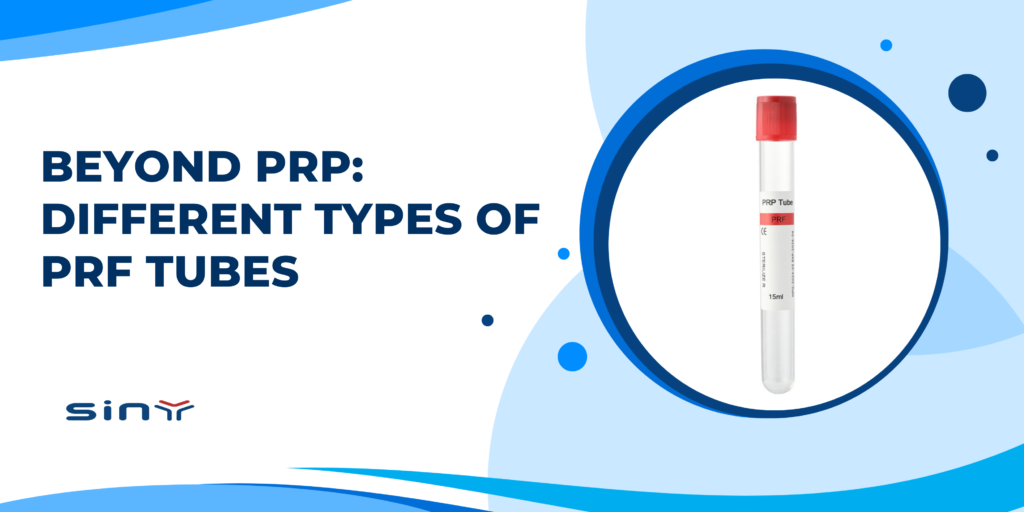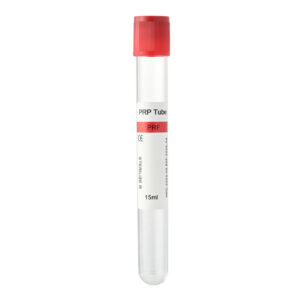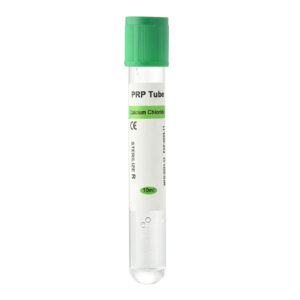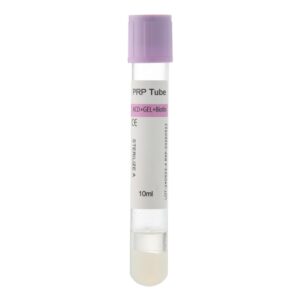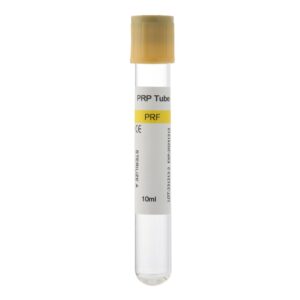Beyond PRP: Different types of PRF tubes. In the world of regenerative medicine, we’re in a constant search for smarter, more natural ways to help our patients heal. For years, Platelet-Rich Plasma (PRP) was the leading name. But today, a more advanced, completely natural successor has taken center stage: Platelet-Rich Fibrin (PRF).
Unlike its predecessor, PRF is a 100% autologous biomaterial created without any anticoagulants or artificial additives. It’s simply a concentration of your body’s own healing power, spun down from a small blood sample. The magic lies in its three-dimensional fibrin matrix, which acts as a scaffold, slowly releasing a powerful cocktail of growth factors, platelets, stem cells, and white blood cells over 7-10 days. This sustained release provides a longer, more potent healing signal compared to the rapid burst from PRP.
However, not all PRF is created equal. The key to unlocking its full potential lies in selecting the right PRF tube for the specific clinical task. Medical professionals design each tube with unique properties to produce a different type of PRF, tailoring it for everything from delicate soft tissue regeneration to robust bone grafting. Let’s explore the essential types of PRF tubes and their specific applications.
Different types of PRF tubes
1. A-PRF (Advanced PRF) Tubes: The Gold Standard for Membranes
Think of A-PRF as the workhorse for creating the perfect biological membrane. The A-PRF protocol is specifically designed to produce thick, durable, and flexible fibrin clots. These clots are rich in leukocytes and growth factors, forming an ideal biological barrier and healing scaffold.
- What it Creates: A supple, cross-linked fibrin membrane that can be stretched, sutured, and manipulated.
- Primary Applications:
- Dentistry & Oral Surgery: A-PRF membranes are invaluable for covering extraction sockets, protecting bone grafts in Guided Bone Regeneration (GBR) procedures, sinus lift operations, and repairing periodontal defects. They accelerate soft tissue healing, reduce the risk of infection, and preserve the underlying bone structure.
- Wound Care: This membrane acts as a living, breathing bandage for chronic wounds or surgical sites, promoting faster and more organized tissue closure.
2. S-PRF (Sticky PRF) Tubes: The Biological Glue for Bone Grafts
One of the biggest challenges in bone grafting is containing and stabilizing the particulate bone material. The S-PRF tube is the elegant solution. Its specially treated plastic surface yields a more fluid PRF that, when mixed with bone graft particles, creates what medical professionals famously know as “Sticky Bone.”
- What it Creates: A pliable, bioactive composite graft that holds its shape and is easy to place.
- Primary Applications:
- Dental Implants: Sticky Bone is a game-changer for socket preservation and ridge augmentation. It allows surgeons to perfectly contour the graft material around an implant or within a bone defect, ensuring the graft stays precisely where they need it for predictable bone formation.
- Maxillofacial & Orthopedic Surgery: Any procedure requiring the precise placement of bone graft material benefits from S-PRF. It transforms loose granules into a manageable, growth-factor-enriched putty.
3. i-PRF+ (Injectable PRF) Tubes: The “Liquid Gold” for Total Rejuvenation
When the goal is to deliver a concentrated dose of regenerative cells and growth factors deep into tissues, the i-PRF+ tube is the answer. This protocol uses a lower centrifugal force to create a liquid, injectable form of PRF that remains fluid for about 10-15 minutes before converting into a gel.
- What it Creates: A liquid concentrate of platelets, leukocytes, and stem cells that can be administered via injection or microneedling.
- Primary Applications:
- Aesthetics & Dermatology: i-PRF+ is the driving force behind the next generation of “vampire facials.” Medical professionals use it to rejuvenate skin, stimulate collagen production, reduce fine lines, and treat hair loss by revitalizing dormant hair follicles.
- Orthopedics & Sports Medicine: Medical professionals can inject it directly into joints like the knee or shoulder to reduce inflammation, manage symptoms of osteoarthritis, and promote the repair of cartilage and tendons. Its liquid form allows for precise delivery to hard-to-reach areas.
To explore more about PRF tubes, visit this category page.
The Simple and Safe Process: From Your Vein to the Treatment Site
Regardless of the tube used, the PRF preparation process is remarkably straightforward and safe:
- Blood Draw: Medical professionals draw a small amount of blood from the patient, just like a standard lab test.
- Centrifugation: Medical professionals immediately place the vial into a specialized centrifuge. The spin protocol (time and speed) varies depending on whether A-PRF, S-PRF, or i-PRF+ is desired.
- Extraction: Within minutes, the blood separates into layers. The practitioner carefully collects the golden-yellow PRF clot or liquid from the middle of the tube.
- Application: Medical professionals immediately apply the freshly prepared PRF to the treatment site, delivering its potent healing factors when they are most active.
You can learn more about the manufacturing expertise of Sinymedical by visiting their About Us page
FAQs: Different types of PRF tubes
Q1: Is PRF treatment safe?
Absolutely. Because PRF is made from your own blood with zero additives, we virtually eliminate the risk of allergic reaction, rejection, or disease transmission. It is one of the safest regenerative treatments available. Any discomfort is typically minimal, similar to a standard blood draw.
Q2: What is the main difference between PRF and PRP?
The key differences are in the preparation and function. PRP requires anticoagulants to keep the blood liquid and releases its growth factors in a quick burst. PRF is 100% natural with no additives and forms a fibrin scaffold that releases growth factors slowly over 7-10 days, providing a longer and more sustained healing signal.
Q3: How long does the procedure take?
The entire process, from drawing your blood to preparing the PRF and applying it to the treatment area, is very efficient. It typically takes less than 30 minutes to complete within a single appointment.
Q4: When will I see results?
This depends on the application. For aesthetic treatments, patients may see some initial volume improvement immediately, with collagen stimulation and skin quality improvements occurring over the next several weeks and months. For bone and tissue healing in dentistry or orthopedics, the results are part of the body’s natural healing cascade, which progresses over weeks to create stronger, healthier tissue.
Summary
Platelet-Rich Fibrin represents a significant leap forward in regenerative medicine, offering a truly personalized and natural path to healing. Its success, however, is not just in the concept but in the execution. Understanding the distinct functions of A-PRF, S-PRF, and i-PRF+ tubes allows clinicians to move beyond a one-size-fits-all approach and tailor treatments with incredible precision. By selecting the right tool for the job, we can fully harness the body’s intrinsic healing intelligence to achieve faster, more predictable, and superior clinical outcomes for our patients.

